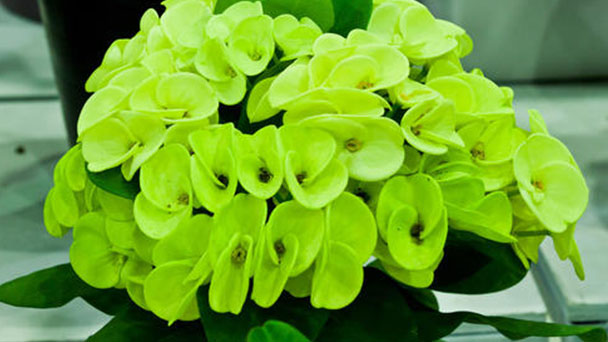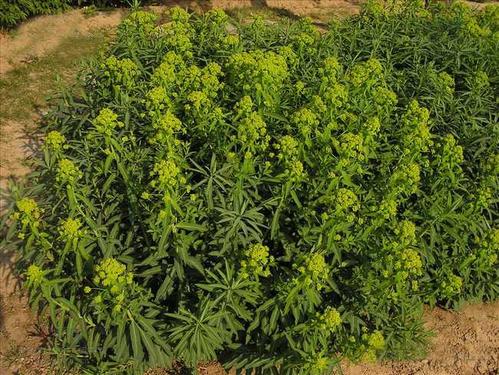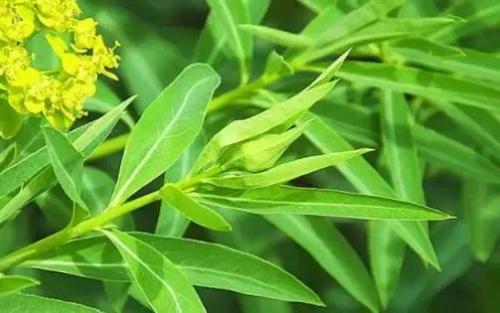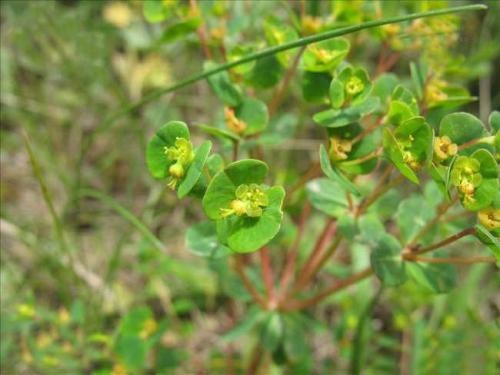Peking spurge (Euphorbia pekinensis) profile
Written by Maggie
Mar 18 2021

The Peking spurge (Euphorbia pekinensis Rupr.) is a perennial herb of the family Peking spurge (Euphorbia pekinensis Rupr.) that can grow up to 80 cm tall. The root is conical. Stem is erect, white pubescent, distally branched.Leaf blade alternate. Moments are oblong-lanceolate to lanceolate. Inflorescence is cup-shaped and altar-shaped. Capsule is triangulate globose, surface with verrucous protrusion. Seeds are ovate, smooth.
Peking spurge picture

Morphological characteristics of the peking sturge
Peking spurge is a perennial herb. Roots are terete, 20-30 cm long.6 -- 14 mm in diameter, branched or unbranched. Stem is solitary or much branched from base, each branch distally 4-5 more, 40 -- 80 (90) cm tall, 3 -- 6 (7) cm in diameter, pilose or lightly pilose or glabrous.Leaves alternate, often elliptic, rarely lanceolate or lanceolate elliptic, greatly variable, apex acute or acuminate, base tapering or cuneate or subrounded or sub truncate, margin entire; Main veins are conspicuous, lateral veins pinnate, inconspicuous, both sides of leaves glabrous or sometimes dorsal leaves slightly pubescent or densely pubescent, variable and unstable; Peking spurge has 4-7 involucral bracts, long elliptic, apex acute, base nearly truncate; The umbrella is 4 ~ 7 in width and 2 ~ 5 cm in length. Peking spurge has 2 bracts, suborbicular, apex mucronate, base truncate or sub truncate.
Inflorescences of Peking spurge are solitary at apex of bifid branches, sessile; Involucral bracts are cup-shaped, ca. 3.5 mm high, 3.5 -- 4.0 mm in diameter, margin 4-lobed, lobes semicircular, margin with inconspicuous ciliate; Peking spurge has 4 glands, semicircular or reniform, light brown. Male flowers are numerous, protruding beyond involucre; Peking spurge has 1 female flower, with longer ovary stalks, stalks 3 -- 5 (6) mm long; Ovary is thickly tuberculate when young; Peking spurge has 3 styles, detached; Stigma is 2-lobed. Capsule is globose, ca. 4.5 mm long, 4.0 -- 4.5 mm in diameter, sparsely tuberculate, split into 3 mericarps at maturity; Style is persistent and easily detached. Seeds are globose, ca. 2. 5 mm long, 1.5 -- 2.0 mm in diam., dark brown or glowy, ventral with pale stripes; Caruncle is subpeltate, sessile.
Ecological Habits of peking sturge
Peking spurge was born at an altitude of 200 ~ 3000 meters, hillside, shrub, roadside, wasteland, grass, forest margin and sparse forest.
The Peking spurge is fond of warm and humid climates. It is drought tolerant, cold tolerant and prefers moisture. The soil requirements are not strict, with a deep soil layer, loose and fertile, good drainage on sandy soil or clay soil cultivation is better.
The region of peking spout
The population is large. Peking spurge is widespread in the whole country (except Taiwan, Yunnan, Tibet and Xinjiang), especially in the north.
Propagation of peking spurge
Peking spurge can be used to seed, root propagation, seedling transplanting method.
Early spring seedlings, broadcast or drill, the seeds evenly planted, thin and fine soil, slightly suppressed, watering, keep the bed soil moist. The seedlings emerge in about 2 ~ 3 weeks. Transplant when the seedling height is 12 ~ 15cm. On a cloudy day, the fixed ground was poured with water, seedlings were dug, holes were opened according to the row spacing of 30cm×25cm and the depth of the holes was 12cm. One Peking spurge was planted in each hole, and the soil was compacted and watered.1hm2 sowing amount 7.5kg. Propagation by root division: After autumn leaves or before early spring germination, dig the roots and divide the roots, each root with 2 ~ 3 buds, and plant in holes according to the row spacing of 30cm×25cm.
Seedlings after transplanting, such as the absence of plants, should be a timely replacement, and 1 time dilute human excrement. Now when the bud should be picked in time, and then apply 1 times manure or cake fertilizer. The soil should be loosened and weeded every two months.

Species classification of peking sturge
Peking spurge
Characteristics Peking spurge, also known as Qiongju Erya, Qiongju Ben Jing, Longhu Herb, Nine Lion Herb, Beijing Peking spurge, General Herb, Tympanites, Tianping Yixiang, Forced Water Dragon, Big Maoer's Eye, Yellow Flower Peking spurge, Yellow Yard Peking spurge, Qiancengta, Sosanhu, Zhuanshanhu, Yi Zhou.
Herbs perennial, 30-80 cm tall, the whole plant contains white milk. Roots slender, conical.Stem erect, distally branched, surface white pubescent.Leaves simple alternate; A few sessile; Oblong or lanceolate, 3 -- 6 cm long and 6 -- 12 mm wide, entire, slightly glaucous below. Inflorescences cup-shaped, usually 5 branched, arranged into a compound umbel; Base with leaflike bracts 5; Each branch branched 2 to several times, branching with 4 or 2 suborbicular bracts, opposite;Male and female flowers without perianth, base of inflorescence bracts sub kidney-shaped; Male flowers in calyx involucre, each flower only stamen 1, filaments fine columnar; Inflorescences with female flowers 1 in center, pistil 1 only, ovary rounded, style 3, apex divided again, protruding from involucre and often pendulous. Capsules triangulate globose with verrucous projections on the surface. Seeds ovoid, smooth surface, grayish brown.
Born along roads, on hillsides, on wasteland and under damp woods.Distribution in Northeast China, East China and Hebei, Henan, Hunan, Hubei, Sichuan, Guangdong, Guangxi and other places.
Red bud Peking spurge
Herbs perennial, 0.3 to 1 m high.Roots usually 2 ~ 3, fusiform, reddish brown residual tan, 0.5 ~ 2 cm in diameter. Stems erect, branches few or unbranched, branchlets with 2 rows of tomentose;S tipules usually 4, connate with petiole, setaceous. Leaves opposite;Having a short or almost sessile; Leaf blade long elliptic linear-lanceolate, 2 ~ 10 cm long, 0.5 ~ 3 cm wide, apex narrow or short acuminate, base cuneate, entire, pubescent above, short velutinous below, especially on veins. Terminal cyme; Flowers bisexual, lavender red or sometimes white, sessile; Calyx 4-toothed; Corolla tubular funnelform, 2 ~ 3 mm long, throat densely covered with long hair, apex 4 lobed; Stamens 4, filaments linear, ca. 1 mm long, anthers oblong, yellow; Ovary inferior, 2-loculed, style slender, stigma 2-lobed. Fruit ovate or elliptic, 4-8 - rowed. Seeds 2, with a hypertrophic fungicule.
Half sunny ground in grass on a low hillside. Distribution in Fujian, Guangdong, Guangxi, Guizhou, Yunnan, Xizang and other places.
Peking spurge uses
Treatment of acute and chronic nephritis edema
Peking spurge root wash, scrape off the coarse skin, slice, with salt 3 money per kilogram, add water to mix well, after inhalation, dry or dried in light yellow, grind fine powder into capsules. Take it twice a day, 1.5 ~ 2 minutes each time, once every other day, take it with warm boiled water on an empty stomach, 6 ~ 9 times as a course of treatment. In more than 60 cases, the edema disappeared completely after 6 ~ 7 days of treatment. Patients had varying degrees of nausea, vomiting and diarrhea after taking the drug. Peking spurge laxative effect is usually the most intense 2 ~ 4 hours after taking the drug. If the symptoms are serious, eat fruit or cold sugar boiled water, the reaction can be relieved. During the period of taking the drug, use a low salt diet, and avoid cold, spicy, fish and pig meat and other hair. Peking spurge is prohibited for pregnant women, heart failure, esophageal varicose veins and the infirm.
Treatment of advanced schistosomiasis ascites or other cirrhosis ascites
The Peking spurge root should be washed, dried, ground and roasted to a brown color. The medicine should be taken in capsules. For adults, 0.6-0.9g should be taken once every other day or 2 days. If the ascites have retreated, ginseng nourishing pills can be used to recuperate. After 5 ~ 36 times of medication, 9 cases showed obvious effect (ascites disappeared, health improved, physical strength basically recovered), 9 cases showed improvement (ascites significantly reduced, general condition improved), and 2 cases showed no effect. During the course of treatment, the main reactions were diarrhea, nausea, vomiting and abdominal pain, which could disappear spontaneously after a few hours. But it has also been observed that generally taking powder 0.6 grams of drug reaction can be tolerated, such as more than 1.8 grams, the reaction weight gain, aversion to cold, tremor, dizziness, irritability, dry mouth, and sometimes extreme fear.Reaction lasts for 2 to 6 hours and can be alleviated if treated in time. The contraindication is the same as before.
Peking spurge is used for edema ascites, chest pain and so on. The Peking spurge is similar to Gansui in its efficacy in drinking water, so it can be used for pleural effusion, ascites, edema and asthma. It is often used in the same way as Gansui and Yuanhua.

Latest Updated
- Benefits of Bugleweed - 7 Science-backed Health Benefits
- Bugleweed Dangers & Side Effects - Is It Poisonous?
- How to Plant Evergreen Trees - What You Should Know
- When to Plant Evergreens - Grow Guide for Evergreen Trees
- 12 Wonderful Evergreen Shrubs for Your Garden
- 12 Popular Evergreen Plants with Pictures for Beginners
- When And How To Prune A Lilac Bush Like a Pro
- How to Grow & Care for Lilac Vine (Hardenbergia Violacea)
- Japanese Lilac Tree (Syringa Reticulata) Care & Propagation Guide
- Shumard Oak Pros and Cons - What to Know
Popular Articles
- Winter maintenance of Antirrhinum Majus
- How to Grow Terminalia Mantaly Tree
- How to Grow and Care for Crossostephium Chinense
- How to grow Antirrhinum Majus in spring
- Peristeria Elata (Dove Orchid) Profile: Info & Care Guide
- Underwatered Snake Plant (Sansevieria Trifasciata) - Signs And How To Fix
- How to Care for Brazilian Jasmine Plant (Mandevilla Sanderi)
- How to Grow & Care for Graptopetalum Purple Delight in Summer
- Rosa Chinensis (China Rose): Plant Growing & Care Tips
- How to Care for Baby Sun Rose (Aptenia Cordifolia)